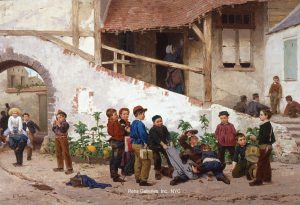 The word ‘expert’ is used (and at times abused) by many people in the art world – “Is he an expert?”, “Who is the expert?”, “Did you show it to the expert?”, “I am an expert!”
The word ‘expert’ is used (and at times abused) by many people in the art world – “Is he an expert?”, “Who is the expert?”, “Did you show it to the expert?”, “I am an expert!”
The real question is – What, or who is an expert? To me, an expert is someone who has studied, in depth, the area they specialize in, seen thousands of works by different artists from the period, and will acknowledge the fact that they are still learning. I am always happy to inform people that while I am considered an expert in 19th century European paintings and, to even narrow that down a bit further, the world’s expert on Daniel Ridgway Knight (1839-1924), Julien Dupre (1851-1910), and Emile Munier (1840-1895), I am always discovering new bits of information about each artist, and learning about ‘new’ 19th century artists.
I use the word ‘new’ because while 19th-century paintings are not ‘new’ and all of the artists have gone to the great beyond, there were so many of them that nobody will know them all, so sometimes an artist emerges that is ‘new’ to me. I know, you are wondering why I don’t know about all of them? Well, there were thousands upon thousands of artists working throughout the 19th and early 20th centuries. In addition, great quality works by many rarely appear on the market, so one just does not take notice. A case in point – some years ago we acquired a beautiful painting by the French Academic artist Antoine Edouard Joseph Moulinet (1833 – 1891). While Moulinet is/was a known artist of the period and exhibited at the Paris Salon, I never paid much attention to the few minor works that appeared on the market. It was not until this work was made available that I took notice. Then the fun began – scouring through our library to find biographical information, looking through our runs of Salon catalogs to see images of other works he exhibited, and reading the reviews of the Salon exhibits for any mention of the artist and his work. While I was able to gather some interesting information about Moulinet, I will, for the balance of my career, be on the lookout for additional information. Not to mention, other quality works by him.
A true ‘expert’ can look at a work by a currently ‘little known’ (new) artist and make the determination as to whether or not it has merit – in their opinion of course. They can determine, just by looking at the painting, its level of quality by referencing works they have seen by other well-known artists of the period, whether the subject matter is appropriate for the time period, and if the artist was working during the height of the period or was someone who came years or decades later. In other words, for us, is the work something we would be proud to own, display and even more importantly, recommend? In the case of the Moulinet, the answers were yes.
Another often asked question is -- How does one become an expert? The answer is easy – by looking and researching. Looking? Yes, viewing tens of thousands of works by the artists from the period and, when it comes to specific artists, studying their work in depth. I do not want to imply that one needs to do extensive, independent, biographical research on the artists (unless you want to become the world expert), but one needs to look at their work, study their paintings, and have a basic understanding of the period in which they lived and worked. By looking, you will train your eyes to see the changes that took place in an artist’s style, subject matter, and quality throughout their career. It is also important to try and find those works the artist dated so one can determine when these changes occurred. You will also find that a real ‘expert’ will have the ability to give a pretty accurate date to undated works, just by looking at them. Only then can someone start to consider themselves an expert, and when other people come to you for an opinion, then you made it.
While many of you will never become ‘experts’ in the area/areas you collect, you will be amazed to find that once you have seen hundreds of works by your favorite artist/artists, when a ‘fake’ appears you will, at the very least, know that something looks a little odd. Remember, most of you are going to rely on someone’s ‘expertise’ to guide and advise you … if you choose wisely, you will be well rewarded!

